Developments in microelectromechanical systems technology promise to enable production of low-cost, compact adaptive optics.
Richard Gaughan, Contributing Editor
In 1953, astronomer Horace W. Babcock of California Institute of Technology in Pasadena proposed a method to compensate for atmospheric and figure aberrations in the optical path of telescopes. In his approach, a rotating knife edge placed in front of an orthicon would serve as a wavefront sensor, and a mirror coated with a thin layer of oil would act as a deformable optical element. The signal generated by the light on the orthicon would drive an electron gun, introducing a spatially varying charge on the oil film and thereby a change in the thickness of the film that would produce a desirable phase change in the reflected light. The idea was well ahead of the technology, and it took decades to develop practical wavefront sensors and deformable mirrors.
At first limited to use on classified projects, adaptive optics experienced explosive growth at the end of the Cold War. The improved image quality is so dramatic that it has become common for a large observatory to incorporate adaptive optics, and its use is expanding to vision science.
As dramatic as the advances in technology have been, however, they do not come without cost. It is expensive to produce deformable mirrors constructed from wafer-thin glass sheets with bonded electrostatic actuators. As a result, adaptive optics has been kept out of many applications.
That may change. Scot S. Olivier, adaptive optics group leader at Lawrence Livermore National Laboratory in Livermore, Calif., and associate director at the Center for Adaptive Optics at the University of California, Santa Cruz, said that adaptive optical systems have benefited from advances in related technologies.
“Other applications have pushed the development of high-end CCD and CMOS sensors and have also driven the development of ASIC technology tools,” he said. “But aside from adaptive optics, there isn’t another driver for advancing deformable mirror technology.”
With some help from the center, small, inexpensive deformable mirrors are on the way.
MEMS to mirrors
Deformable mirror manufacturing is leveraging off technological advances in microelectromechanical systems (MEMS). For example, AgilOptics Inc., formerly Intellite Inc., of Albuquerque, N.M., has produced an electrostatic deformable membrane mirror using micromachined silicon membrane technology developed and patented at Stanford University in California (Figure 1).
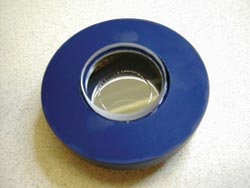
Figure 1. Adaptive optics is leveraging off technological advances in microelectromechanical systems technology to produce components such as this electrostatic deformable membrane mirror. Courtesy of AgilOptics Inc.
The five-step process begins with a silicon wafer, coated on each side with a layer of silicon nitride. Mirror-size regions of silicon nitride and the bulk silicon are etched away, leaving a thin silicon nitride membrane. The membrane is coated with a reflective aluminum layer on one side and a conductive gold layer on the other. The conductive membrane structure is suspended above a conductive array of actuator pads. Voltages applied to the conductive pads induce electrostatic forces that attract the gold conductive surface, deforming the membrane.
Standard mirror sizes are 10, 16 and 25 mm, although deformable membrane mirrors as large as 125 mm have been fabricated. With 110 V applied to all of its 37 actuators, a 25-mm-diameter mirror can introduce 7λ of focus in a 633-nm beam (Figure 2). Driving the actuators in different patterns produces higher-order corrections.
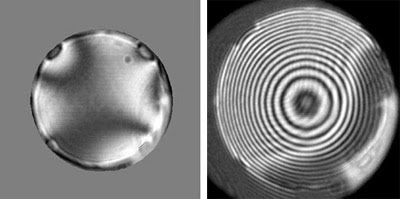
Figure 2. MEMS technology brings large capabilities to small packages. A 25-mm-diameter, 37-actuator deformable mirror can go from less than 1λ deviation from flatness to 7l of focus at 633 nm. Courtesy of AgilOptics.
AgilOptics provides a standard product line, including such items as a 50-mm-diameter Cassegrain telescope with an integral deformable secondary mirror. Custom work, however, remains the norm.
“Initially, most customers will want something off the shelf to check out our system,” said Anna M. Miller, AgilOptics’ technical marketing engineer. “However, most customers have specialized needs, and we are ready to help them by having the ability to design mirrors for each application.” The company’s high-fidelity modeling software takes a given set of design parameters, such as mirror thickness, number of actuators and spacer size, and generates a prediction for mirror deflection as a function of actuator voltage.
MEMS Optical Inc. of Huntsville, Ala., also uses MEMS technology in the miniature deformable mirrors it is developing, including its vertical comb array microactuator continuous membrane mirror. Using deep reactive ion etching, wafer bonding, grinding and polishing, and metal deposition, the company generates the three-dimensional vertical comb array microactuator structure. A series of parallel vertical plates is built atop a horizontal substrate. Another series of vertical plates is built as a frame structure, interdigitated with the bottom series. The top vertical frame structure, called the slider, is attached to the substrate by a spring. With the application of a voltage to the comb structure, the slider moves relative to the substrate.
The interlocking vertical combs linearize the electrostatic force in the actuators, resulting in accurate motion of the piston element. When connected to a continuous membrane, the vertical comb array microactuator produces a stroke as high as 6 μm for an applied voltage of around 150 V. In a segmented design, each actuator theoretically could move up to 1 mm, which could open applications in other regions of the electromagnetic spectrum.
Flexible Optical BV (OKO Technologies) of Delft, the Netherlands, in cooperation with the Delft Institute of Microelectronic and Submicron Technology, produces its micromachined membrane deformable mirror with a 500- to 700-nm-thick silicon nitride membrane fixed to a silicon chip. The membrane surface is coated with a metal or a highly reflective metal/dielectric coating, and it is suspended over an array of electrostatic actuators. Standard mirrors are available with membrane diameters of 10 to 50 mm and with 37 to 79 actuators (Figure 3).
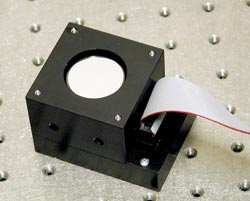
Figure 3. This 19-actuator micromachined deformable mirror is produced using scalable MEMS techniques. Such manufacturing promises to bring down costs, perhaps to less than $10 per actuator, in the near future. Courtesy of Flexible Optical BV.
Gleb Vdovin of the company said that it appears impossible to use a standard adaptive optics product to address every customer’s needs. Instead, Flexible Optical is developing interchangeable components that can be combined and integrated into a variety of adaptive optics systems. He said the elements could be assembled into a variety of systems to solve a number of problems in diverse fields.
The company’s micromachined membrane deformable mirrors have been used in ophthalmic systems to correct the aberrations of the human eye, and in low-cost adaptive solar telescope and satellite tracking systems. A linear version of the mirror was used to optimize high-order harmonic generation in a Ti:sapphire-pumped system, where it showed an improvement in ultraviolet intensity by a factor of six.
For applications that do not need high bandwidth, Flexible Optical also offers a thermal deformable mirror, which is constructed by attaching an array of actuator resistors to the back of a flexible plate. Passing a current through the resistors increases the temperature and changes the actuator length. Although the response time is relatively slow, the low cost of the mirror makes it an attractive choice to compensate for slowly varying optical aberrations.
Boston Micromachines Corp. of Watertown, Mass., also has developed optical MEMS. Besides three configurations of micro deformable mirrors, it offers three models of micro spatial light modulators. The packages vary from a 100-actuator, 3.3-mm-diameter micro deformable mirror (Figure 4) to a 1024-actuator, 10.5-mm-square micro spatial light modulator. The deformable mirror is a continuous membrane surface, while the spatial light modulator consists of individual 3-μm-thick, 300- or 338-μm-square segments.
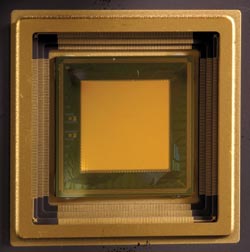
Figure 4. MEMS manufacturing techniques enable small deformable mirrors to display high performance. This actuator array incorporates more than 1000 actuators. Courtesy of Boston Micromachines Corp.
The mirrors are suited to wavefront control applications in adaptive imaging or beam forming, for which aberrations are expected to be smooth and continuous, said Tom Bifano, chief technical officer of Boston Micromachines. The spatial light modulators, on the other hand, are targeted to single-wavelength applications. “In particular, you can take advantage of phase wrapping to provide wavefront correction magnitudes over the aperture that are much larger than the available actuator stroke, similar to the way a Fresnel lens works,” he said.
For both configurations, actuator posts connect the back of the face sheet to an array of flexible silicon membranes. Each membrane in turn is suspended above a silicon electrode. Voltages applied to the electrodes attract the silicon membranes, causing the mirror face sheet to deflect in the case of the micro deformable mirrors, or the mirror segment to translate in the case of the spatial light modulators.
Paul Bierden, president of Boston Micromachines, believes that the advantages in size, speed and lack of hysteresis give MEMS deformable mirrors the edge over traditional ones, but he said that cost is a big factor. Macroscale deformable mirrors and associate drivers, he noted, cost several thousand dollars per actuator. In contrast, the company’s MEMS applied optics systems cost $5000, including all associated hardware and software. The company is working to lengthen actuator stroke beyond 4 μm and to increase the number of actuators beyond 1000, but he said that the device technology is mature.
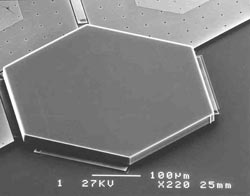
Figure 5. This hexagonal mirror segment is 350 μm on a side and is flat to within a few nanometers. The 3-D MEMS structure of the deformable mirror holds the segment off the substrate and offers both tip-tilt and piston motion. Courtesy of Iris AO Inc.
Iris AO Inc. of Berkeley, Calif., has developed a MEMS-based segmented deformable mirror composed of 700-μm-diameter hexagonal sections that are linked to a substrate via three bimorph flexures (Figure 5). Driven by three electrodes on the substrate, each segment is capable of tip-tilt and piston motion, and the company has demonstrated a segment stroke of more than 10 μm at a bandwidth of better than 1 kHz. The segmented design allows each reflective element to be relatively thick, so individual segments are flat to within a handful of nanometers over a wide temperature range.
The first devices have 37 actuators covering a 3.5-mm inscribed diameter with a 98 percent fill factor. Iris will ship engineering samples in the next couple of months and plans to make off-the-shelf devices available before year’s end.
MEMS approaches are suited for applications that require small, lightweight, low-power or low-cost devices. According to Iris President Michael Helmbrecht, it’s easy to tailor the design of these devices to fit specific needs while maintaining the existing system’s architecture. “Adaptive optics is truly an enabling technology,” he said. “For example, adaptive optics can compensate for high-order aberrations within the eye in a way that a simple spectacle lens with focus and astigmatism corrections cannot. With adaptive optics, individual retinal cells have been imaged in vivo.”
Helmbrecht’s goal is to produce a robust design that is a step closer to being a commercial device. Such a design should be usable over a wide temperature range and should be built from the ground up as a reliable component, he said.
High capability in a low-cost package can reasonably be expected to broaden the range of adaptive optics. Bifano outlined target markets as applications that display significant aberrations. Examples include astronomy with large telescopes, confocal microscopy through tissue, imaging the retina through a misshapen cornea, compensating for thermal gradients in laser welding beam paths, and laser pointing along horizontal, near-ground paths (Figure 6).
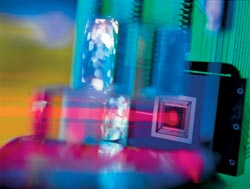
Figure 6. Adaptive optics is well-suited to situations in which aberrations in the beam path cause significant degradation. Relatively inexpensive microelectromechanical deformable mirrors can improve the quality of ophthalmologic imaging or keep an industrial laser beam optimally conditioned. Courtesy of Boston Micromachines.
According to Olivier, the cost and size advantages of MEMS deformable mirrors are critical for many such applications. For ophthalmology, an instrument that can be used in a doctor’s office should fit a portable cart and should cost less than $100,000, he said. Next-generation astronomical systems will require up to 10,000 actuators, again making cost a driver.
But will those markets materialize? Olivier believes the current market for adaptive optics is in a Catch-22. “If there were a bigger market, batch processing would drive costs lower,” he said, “and if the cost were lower, then there would be a bigger market.”
A typical benchmark cost for conventional deformable mirrors is $1000 per actuator. MEMS versions are about an order of magnitude less than this. If the market grows, industry sources suggest that $10 per actuator could be reasonable. If the markets blossom, as some expect, manufacturing economies could drive the price even lower.
The prospects were outlined in Industrial and Medical Applications of Adaptive Optics, a technology forecast published by the Institute of Physics in Bristol, UK. According to authors Alan Greenaway and James Burnett, there is a movement in adaptive optics away from complex, custom systems toward the development of inexpensive components and subsystems that can be assembled by nonexperts.
A key area for development is in advanced wavefront sensors. The authors claim that overall system performance is limited by the availability of inexpensive, high-performance wavefront sensors.
For example, AgilOptics has a system suitable for astronomical imaging, but the full wavefront sensor control system operates at up to only 3 Hz. Miller noted that the mirror and electronics are fast enough; the wavefront sensor and frame grabber are the limiting factors. Nevertheless, she said, the current generation of miniaturized adaptive optics systems is “faster, cheaper and not as cumbersome as previous systems.”
When faster, inexpensive wavefront sensors become available, the next-generation systems will move even closer to turnkey operation. AgilOptics plans to offer a complete system with a dedicated microprocessor for less than $20,000.
The timing may be just right. Burnett and Greenaway suggest that the next five years will be crucial in determining whether adaptive optics achieves the level of a mainstream technology.
Will adaptive optics’ price and performance advantages drive new applications? Given the technological advances since 1953, it’s easy to imagine that Babcock would think the chances are good.
Sending the Right Signals
Having a deformable mirror that can compensate for the aberrations in an optical system is only the first step. Sensors also must be built and integrated with the optical system. Then comes the control system engineering, converting output from the sensors to drive signals for the mirror actuators.
Generating control system signals is a nontrivial task. The so-called influence functions of the deformable mirror — the effect of actuator voltage on reflected wavefront — must be determined. When the sensors detect an aberrated beam, the influence functions are used to determine the correct voltages to apply to reverse the aberrations.
Typically, there are two approaches. One is to use the input from a wavefront sensor to measure the difference from the ideal wavefront and to apply voltages to induce the exactly opposite wavefront on the deformable mirror. The second is to define a system metric — the smallest spot size or greatest encircled energy, for example — and to input metric measurements to an optimization algorithm.
Several companies offer system packages that include control software. Flexible Optical BV of Delft, the Netherlands, supplies closed-loop adaptive optics systems based on its Shack-Hartmann wavefront sensor that can be interfaced directly to its piezoelectric and micromachined membrane deformable mirrors. The software works with hexagonal, square and irregular spot patterns. The sensor also may be used in stand-alone mode, in which it reconstructs the wavefront profile, interferogram, far-field intensity and Zernike wavefront components and can be used for the dynamic display of low-order aberrations.
AgilOptics Inc., formerly Intellite Inc., of Albuquerque, N.M., also provides control software as part of an integrated system solution. The hope is that low cost, small size and low electrical power requirements will bring inexpensive adaptive optics to new applications — even to such ordinary uses as optimizing coupling into optical fiber.
In a proof-of-principle test, AgilOptics coupled HeNe laser light reflected from a deformable membrane mirror into a 4-μm single-mode optical fiber. The signal from a photodetector at the fiber output was used as the system metric. Using a combination of three control algorithms, the adaptive optics system increased fiber coupling by 75 percent over the static alignment. Because the deformable membrane mirror also can correct for tip-tilt errors, the system can compensate for laser drift.